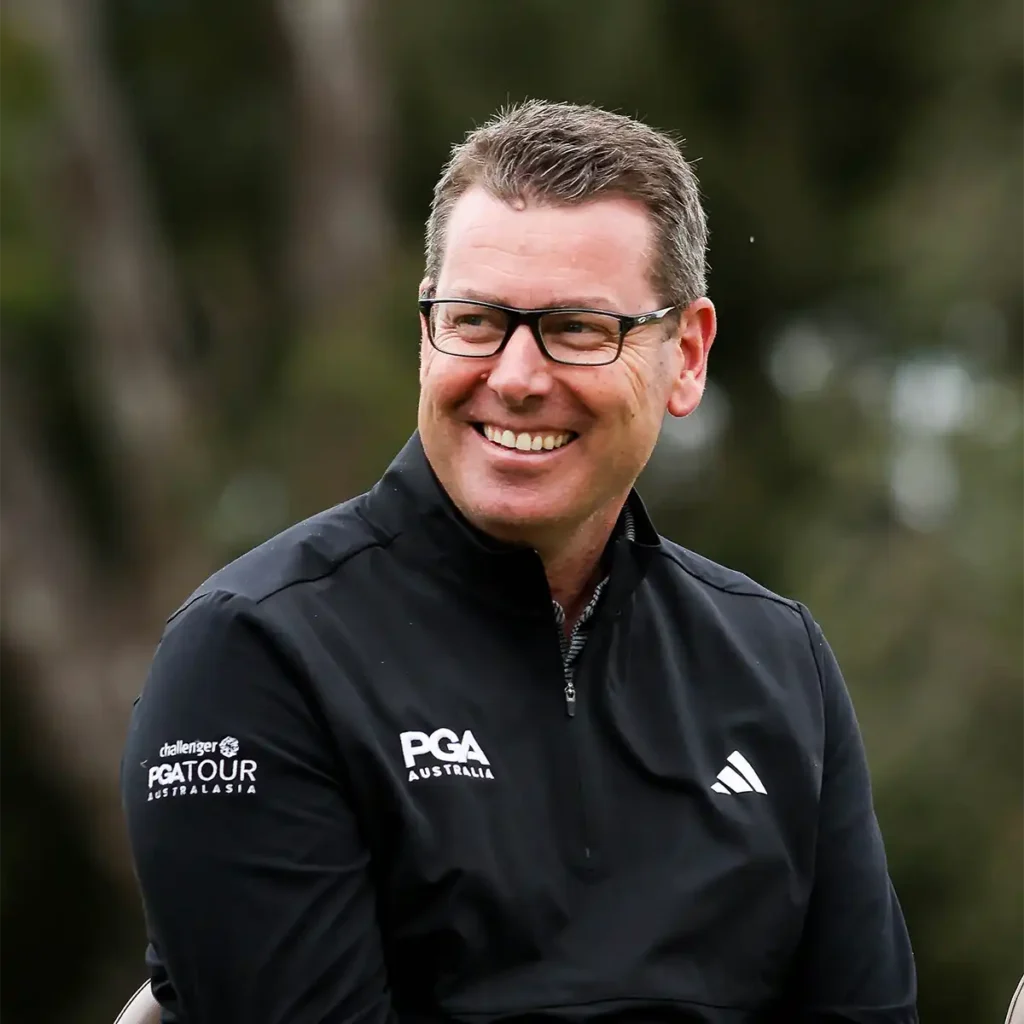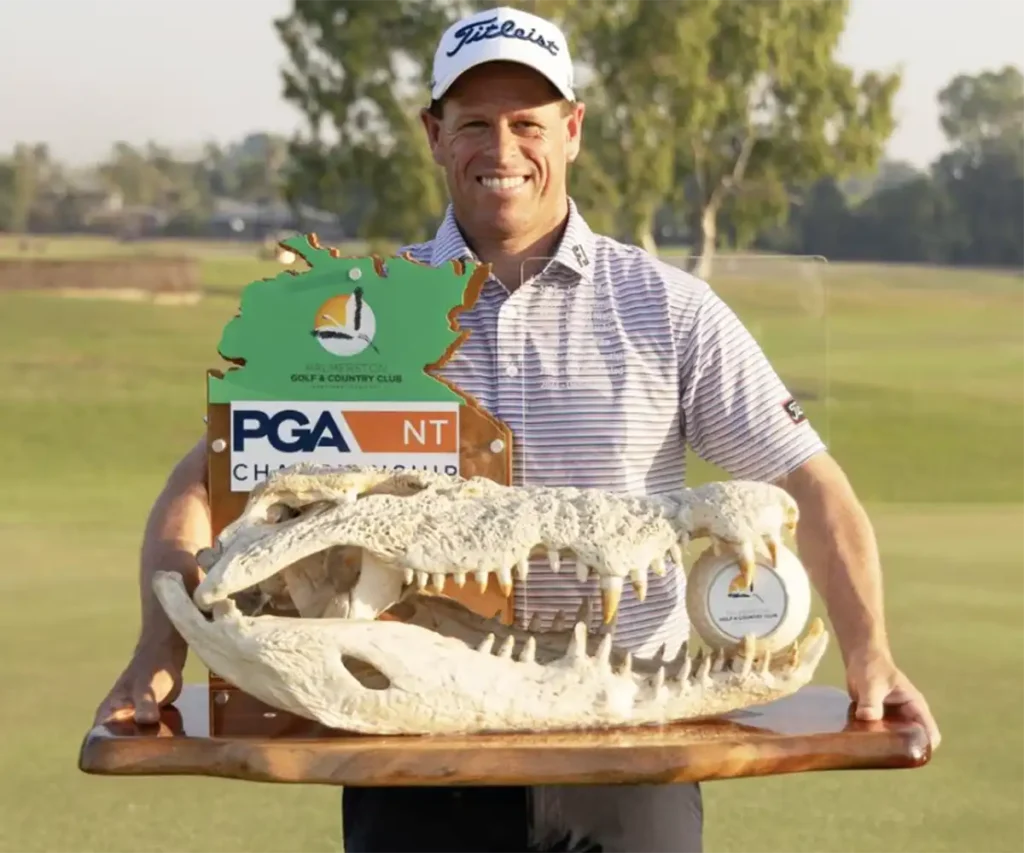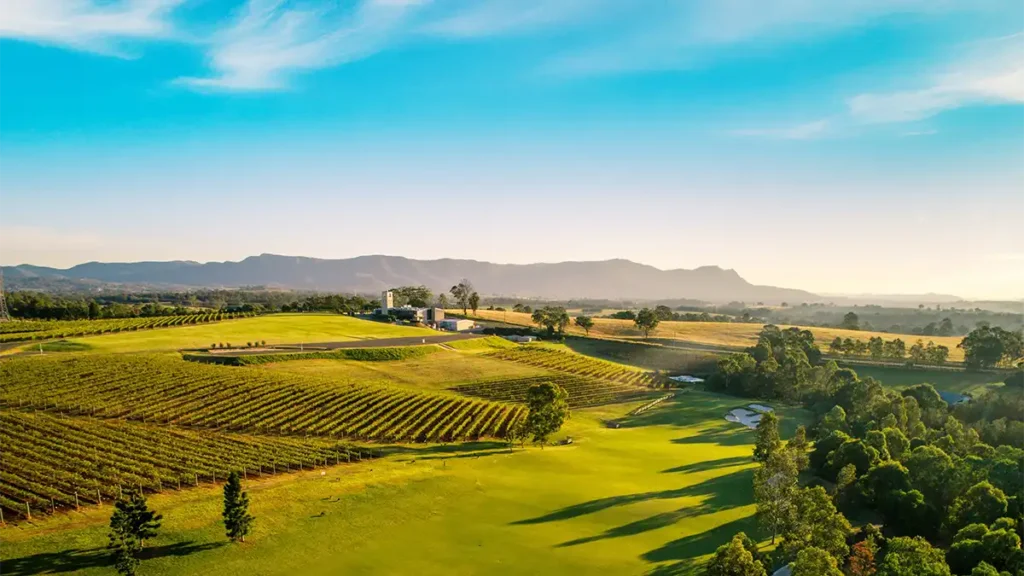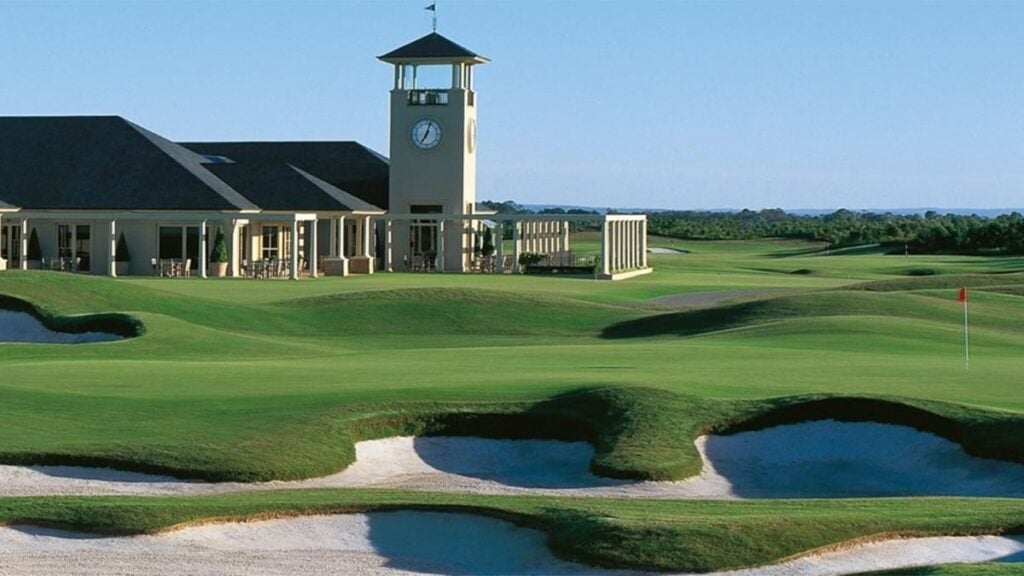While most fans only see the trophies and tee-times, the real work of restoring Australian golf’s professional heartbeat has happened quietly, behind the scenes. The PGA Tour of Australasia’s Nick Dastey and Kim Felton share how a six-year masterplan is bearing fruit, and why the best is yet to come.
When perusing the list of tournaments on the PGA Tour of Australasia, it’s easy to have your attention directed to a single fortnight in late November and early December, when the two shining lights of the local circuit – the Australian PGA and Australian Open championships – are held. In truth, though, almost every week from early October to late March includes a tournament, with two earlier events staged in August. It’s a six-month carnival that touches Darwin, Perth, Adelaide, Brisbane, Melbourne, Sydney, Papua New Guinea, New Zealand and all manner of exotic places in between.
Helping drive the growth of the tour are Nick Dastey and Kim Felton. Dastey is the PGA Tour of Australasia’s general manager of tournaments and global tour relationships, while Felton is the tour development manager and a 15-time tournament winner during his playing days. We caught up with the pair shortly before the current season hit full stride to discuss tournament venues, player recruitment, giving rising stars more airtime and plenty more.
▶ ▶ ▶

Australian Golf Digest: We recently came across an interesting article from one of our 2019 issues about the five-to-10-year plan to build the PGA Tour of Australasia from just the two major events – the Australian Open and PGA. It was essentially you two detailing how you want to offer a consistent number of 72-hole events. Looking back, how do you feel that plan has come along?
Nick Dastey: I would say pretty well. We were aiming to expand the tour and get to a point where our best players who weren’t playing on overseas tours had a genuine pathway and a genuine tour to play on that allowed them to play week in, week out. Back then, we would’ve been talking about trying to elevate the tour to somewhere between 20 and 25 events and we’re effectively at that point as far as numbers go – we’ll have 20 on this year’s schedule. At the end of 2019, we were down to 12 events on tour and we had just lost [the World Super 6] Perth at that stage, so we only really had the two big ones in the Australian PGA and Aussie Open. The New Zealand Open was obviously still there and has continued to grow in these past five years. Back then it was just over a million dollars in prizemoney and earlier this year was closer to $2 million. And the Vic Open was on there, but as we all know, that quickly changed once COVID hit.
So yes, theoretically we had 12 events at the end of 2019, and to have 20 on the circuit now, it gives the players that aren’t playing overseas a real chance to play week in, week out, particularly between October and March. Becoming more competitive, more rounded as tour players and tournament professionals allows them a chance to compete with the guys that are playing weekly.
If you go back and look at a lot of our leaderboards from our major events through, say, the 2000s, if you look after round one and round two, you’ll probably see a number of local players that are up on those leaderboards, but nearly everyone in the top 10 by Sunday afternoon was predominantly guys that were playing on international tours week in, week out. Now what we’re finding is we’ve got guys that are home-grown that haven’t made it overseas yet but are able to be competitive in our bigger tournaments across the four days. I have little doubt that’s got to do with the fact they’re playing more tournament golf and playing in better tournaments more often. It makes a massive difference in their development.
Kim Felton: That’s happening in the women’s game as well, mainly through the Webex Players Series. That’s helped strengthen their games as well by not just playing with the men, but having more events down here of that level. The vision was always there to create more events and more opportunities and, as Nick said, I think we’re at a point now where we’ve got a pretty good platform and now it’s all about just growing more opportunities and pathways, which has always been the key.
But there were also a couple of things that probably – not fell in our lap, as it was the most awful time, especially for Victorians – but through COVID was to have a good look at how we could improve it. One was changing from a calendar-year season back to the summer of golf and the other was going to [an Order of Merit based on] points.
▶ ▶ ▶

Going to quality golf courses has been energising as well. Has that been a focus, as well as the players and the sponsors and the actual events themselves?
Dastey: The quality of golf courses is certainly a focus. It’s not a matter of just staging an event wherever we can. We certainly want to be able to stage our events on the best possible venues and venues that are going to test. I guess that comes about, though – as the tour gets stronger and is seen in a more positive light, that venues recognise the value in being a host venue for an event and how it can enhance their brand as well. I think it goes hand in hand. As we get better as a tour, as we grow, there’s going to be more interest from those better venues to host an event. But hosting an event, particularly for a private members’ golf club, they do have to make some sacrifices. They’re giving up their venue for certainly at least the week, sometimes a little bit longer.
Felton: There’s also the golf courses outside those traditional, amazing courses – regional courses like Willunga or Palmerston, where the Northern Territory PGA is held. They have made significant investments into their courses through hosting a PGA Tour of Australasia event. And to have that on TV and really highlight… how much they’re changing and improving. Not just condition-wise, but having people understand that Willunga’s got a bloody good golf course there as well as Palmerston. So it gives those lesser-known courses a good opportunity as well.
▶ ▶ ▶

How satisfying was it to finally get the stars to align to get the Australian Open back to Royal Melbourne and have Rory McIlroy make good on something that he had been verbally promising to the golf world: that he would come Down Under?
Dastey: It’s extremely satisfying. It’s an amazing thing to think that the Australian Open, our national title, hadn’t been played at Royal Melbourne since 1991. But that happened for many different reasons. The fact that it is back there this year, the fact that a top-three golfer of our generation is coming down to play and hot off the heels of winning the career Grand Slam, the interest that that’s generated, like you said, the stars have aligned in many respects.
The interest is generated for not just the Australian Open, but I think the Summer of Golf in general and we’re in for an exciting time over the coming months and hopefully what’s generated through those couple of weeks really plays out right across the whole summer. And knowing that Rory’s coming back again in ’26 to Kingston Heath really gives us a good window to drive the game forward down here and really drive our tour forward, because there will be a lot more eyes on it than there has previously been. Wherever Rory goes, the eyes of the golf media go. So it is a really positive thing for our tour and for the Australian Open.
Felton: With Nick and I talking to players – not just marquee players but players around the world – I’m gobsmacked by the amount of interest in players wanting to come and play both events. Royal Melbourne will do Royal Melbourne things – an Australian Open title does that, and then adding Rory and others to that field – but also the BMW Australian PGA Championship now the week before with increased prizemoney. The players all around the world are keen to come back and play. It’s two weeks the players are really aware of, particularly with what the Masters invitation has added to the Australian Open.
▶ ▶ ▶

The Australian PGA has built such a good identity in Brisbane at Royal Queensland. With respect to the 2032 Olympics and renovating Royal Queensland, how do you keep the momentum going for the championship?
Dastey: Royal Queensland’s been an amazing partner for the tournament and for the PGA in general, so that’s difficult to replace. However, what we’ve been building on with the tournament hasn’t been totally reliant on the golf course. It has really been about the atmosphere, the feel to the tournament, a real player-first mentality around everything we do with the tournament as well and trying to make sure that all our players – in particular our international guests – are well looked after at the tournament. Then what we’ve been doing with on-course fans in particular, again, the atmosphere of the event, the Party Hole on 17… The whole vibe of the event has been around it being a fun place to be for the week, and I think we can replicate that at whatever venue we end up at.
Regarding a [future] tournament venue, we’ve got a bit of work to do to ensure that where we end up we can replicate all of that. But I think a lot of what we’ve been doing in building the tournament has not necessarily been about the golf course, it’s been about a lot of other things and Kim touched on it just before, record prizemoney this year for an event on our tour going to $2.5 million and we want to continue to build it.
▶ ▶ ▶
What’s something that Australian golf fans don’t know about the day-to-day, week-to-week recruitment process for the two big events?
Felton: There’s two parts to being a golf tour that players want to come back and play. One is for legacy and golf courses and the other one is just purely: you create a great event that people want to come back and play. A perfect example of that was the Coolum Classic in the late ’90s, then through to the Australian PGA being at Coolum. That was an event players loved coming back for. It was a time of the year that worked for them and they could let their hair down and have some fun while playing some good golf.
Those two events have some great history. They are DP World Tour co-sanctioned events, which ticks that box, and players want to come and play. The recruitment side’s pretty easy from our end, knowing we have two great golf courses, two great tournaments and our Australian players are great supporters of golf in Australia. They all want to come back.
Nick, would you say each year we start discussing it early in the piece? Nick’s at the Masters, he’s at The Open, there’s a discussion around dates and where they’re going to be and the chat is, “You can come and play,” but we’re pretty lucky that they are two great events in Australia that people want to come back and play.
Dastey: The Australasian side of the conversation is an easier conversation than the international-player side of things. Like Kim said, most of our guys are keen to come down and play and we obviously work with them to make that happen and to try to lock them away for those weeks and try to ensure they can come down. With international players, things can start early in the year and yes, discussions happen around Augusta time because it’s that six, seven months out from the tournaments and people are starting to get a bit of an idea of where they stand and what they might want to do [at the end of the year]. And our events are obviously after the PGA Tour season, after the DP World Tour season’s just finished, so we can start to have those chats. Certainly around The Open, you start to get a better idea of where people are at, but some are more prepared to commit further out than others.
A focus from our side has been trying to bring out some of younger talent as well. The talent that we’re looking at and have that gut feel might be a top-20-in-the-world player in the next few years, because we believe that if they come out here and experience both events, experience the great golf courses and are well looked after when they’re here, it becomes the norm for them or something that they want to continue to do throughout their career. Having someone like Aldrich Potgieter down last year is one example, and that was a perfect opportunity. He was right in contention at the Australian PGA Championship as well.
Things like that are certainly a focus when it comes to the player side, but we obviously want to get some of the stars down as well. That’s not easy and there are so many opportunities for them out there, not only on the PGA Tour and the DP World Tour, but elsewhere where there’s a lot of money in the game. We can’t appeal to them necessarily on the money front, so we need to appeal to them in other ways. Hopefully our country does a lot of that for us and our golf courses do a lot of that for us, but it’s also making sure, like I said before, of that player-first mentality of trying to make sure we look after them while they’re here and that they enjoy their time.
▶ ▶ ▶
Back to Rory McIlroy, I’ve spoken to Golf Australia’s Antonia Beggs about just what it took to get him here, but in your experience, what’s something we don’t know about the effort to lure Rory back Down Under?
Dastey: Well, Rory has spoken so strongly about the Australian Open, about national opens, about the Sandbelt over many years. It’s not just once that he’s put that out there. It’s been put out there on numerous occasions since he was down here last, won the [2013] Australian Open and then came back and defended. There’s been numerous discussions that have taken place with Rory and his management by various people within not only Golf Australia but the PGA as well about him coming back. At the end of the day, the time was right for him; it worked for him. He had, again, spoken glowingly about national opens in general, and the Australian Open, and it’s clearly something that’s high on his agenda – not just the Australian Open but playing golf around the world and supporting events he feels should be seen as important events. He’s talking with his feet, basically, by jumping on the plane and coming down here and playing.
▶ ▶ ▶

To the other end of the spectrum in terms of stature, it felt like last season was the first time in a little while that it was really engaging to get to know these characters, from Ryan Peake to Anthony Quayle to Harrison Crowe to Jack Buchanan. How much do you see that as part of the Aussie tour’s future – keeping the stars coming to the two big tournaments, but also telling the stories of the lesser-known players?
Felton: That goes back to a vision we spoke about to have TV coverage of every event. Look at Elvis Smylie three years ago – a golfer who comes out, turns pro, has a year or so battling, then wins the WA Open on TV. Everybody sees who that is and then he wins the Australian PGA Championship and is now a DP World Tour player and is very close to potentially getting a PGA Tour card in that short space of time. That was always part of the vision. Our media team’s done really well exposing those younger players to TV and more media.
Our team is not grinding them all the time, but they’ve got options for them to learn and improve. And getting in front of cameras, not just playing, but doing what we’re doing now for certain events helps that. Part of the focus is continuing to get them on TV and showcase these players. It’s all about getting people to know who they are.
Dastey: I think it’s the most important thing, to be honest. It’s more important than bringing Rory down for the Australian Open in many respects from a tour perspective – providing the platform for that next generation of Australasian players to be as good as they can possibly be. And you only need to look at David Micheluzzi, Kazuma Kobori and Elvis – three guys that have made their way to the DP World Tour in the past three years through winning the Order of Merit or winning the Australian PGA Championship and all three easily holding their own on the DP World Tour. It’s not that long ago that Dan Hillier was travelling over here during COVID, leaving New Zealand knowing that he couldn’t get back, to play our events during that period. And Elvis is very, very close to potentially getting one of those PGA Tour cards through the DP World Tour. And there’s numerous players that if they didn’t have the opportunities here, it’s not to say they wouldn’t eventually make it overseas, but no doubt it makes it harder. So all the events outside our ‘majors’ are, from an overall tour point of view, the most important platform from our side of things.
Felton: Other sporting players have done it so well, so we’re just trying to do the same thing. We can provide the platform for them to be seen on, but to be honest, we need them to be engaged and work with us for that. And that’s the part where I’ve probably seen the biggest improvement – how comfortable they are now in front of cameras. They’re keen for it. We ask them to do a lot and 99 percent of that time, they all do it. So that’s where you’ve got to give the players the credit for being willing to move with what we want to see them do.
Main photograph by Chris Hyde/getty images



